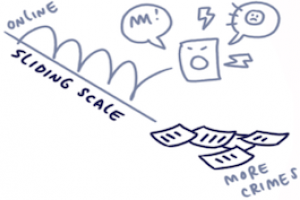The role of the Internet in transgressive behaviour: New tool or a new phenomenon?
Over the last few decades, crime and transgressive behaviour have been declining in many Western countries. However, there is evidence that – at the same time – online forms of transgressive behaviour are increasing, and in fact seem to be increasing quite rapidly. For instance, the percentage of young people who report being the victim of online harassment has increased from 6% in 2000 to 11% in 2010. As such, a greater understanding of online transgressive behaviour is needed urgently. One way to promote a holistic understanding of the phenomenon is to integrate insights from different fields into a cross-disciplinary framework of online transgressive behavior. Here, we would like to introduce you to a new research collaboration within Leiden University, which brings together legal scholars, philosophers, psychologists, pedagogical scientists, and criminologists to study online transgressive behaviour. The central question underlying this project is: Is the internet simply a ‘new tool’ for perpetrators to carry out transgressive acts? Or should online transgressive behaviour be seen as a new and distinct phenomenon?
Online to offline forms of aggression: A sliding scale?

When considering the relationship between online and in-person forms of transgressive behaviour, online behaviour is sometimes seen as a starting point to in-person aggression. This is the ‘sliding-scale’ view of transgressive behaviour. However, evidence for this ‘sliding-scale’ view is difficult to establish as researchers struggle to determine a temporal relationship- what comes first, the online or the offline form of aggression? Instead, the focus is can be shifted to determining an overlap between online and in-person transgressive behaviour, again with mixed results. A survey on middle school children, for instance, showed only a small overlap between cyberbullying and ‘offline’ bullying. On the other hand, in the context of romantic relationships, there is evidence that online violence is likely to co-occur with in-person forms of relational violence, such as physical or emotional violence.
How is the Internet different from the “real world”?
While it seems there are at least some forms of online transgressive behaviour that show overlap with in-person transgressive behaviour, the rise of the internet has also paved way for forms of transgression that exist exclusively in the online sphere, such as trolling or catfishing. There are several noteworthy features of the online environment that perpetrate transgressive behaviour and differentiate it from offline transgressive behaviour. First, when interacting through the internet, the recipient is physically distant and (as a result) psychologically remote, which is known to decrease feelings of empathy. Relatedly, the internet provides a sense of anonymity, which is known to facilitate unethical behaviour. The online environment is also characterised by the relative absence of top-down regulation by the law. This absence of guidance may blur the lines between acceptable and unacceptable behaviour. The absence of regulation is also evident when we consider parents’ control over the behaviour of their children online - much of children’s behaviour is not visible to parents. In the absence of such guidance, through the virtue of anonymity and the remoteness of the recipients, young people may be tempted to engage in behaviours they would otherwise find objectionable in-person. Thus, children and teenagers, by virtue of this online disinhibition effect, are particularly likely to become involved in transgressive behaviour online, both as perpetrators and as victims. Indeed, there is evidence that, in 2019, 3 out of 10 young people reported engaging in what they considered to be online transgressive behaviour.

In sum, the online environment seems to have several unique features that not only facilitate the occurrence of transgressive behaviour, but also gives rise to new types of transgressive behaviour that occur exclusively online. By examining how these issues contribute to online transgressive behaviour, our interdisciplinary Social Resilience and Security team hopes to generate a greater understanding of online transgressive behaviour, its consequences, and how we might encourage resilience to online transgressive behaviors. You will surely hear more from us as the project progresses! For now, those who are interested in finding out more about this collaboration can do so on our website or by following us on twitter (@leidensrs).




